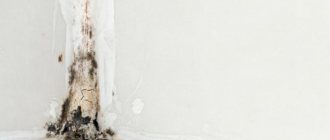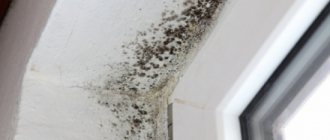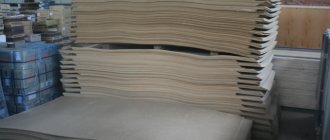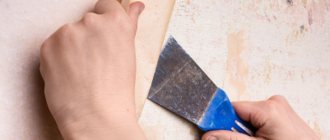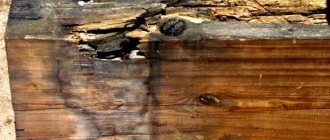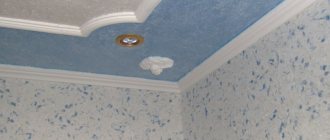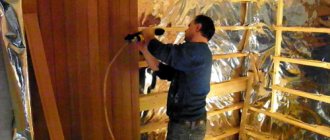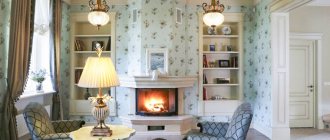Since ancient times, people have always shared their homes with other inhabitants of the animal and plant world: even in modern high-rise buildings, mice, spiders, cockroaches, bedbugs and various small animals are found every now and then. But if a person can put up with some illegal tenants and not pay attention to them, then living next to others is dangerous to life and health.
Enemy number one is mold stains in living spaces. These black and greenish-brown spots do not bite anyone, but it becomes impossible to live in the house. In addition, sometimes a fungal colony can camouflage itself and live on the back side of the wallpaper for years, without external manifestations, gradually growing and capturing new territories. So, what to do if mold appears under the wallpaper? How to deal with it? And is it possible to win this war alone?
What is mold
Molds are tiny microscopic fungi that look like intertwined threads (hyphae). The spores of these microorganisms are found everywhere - in the air, in water, on the street, in any room. Until there are suitable conditions for them, they do not manifest themselves in any way. But as soon as possible, they will create a colony on any suitable surface. When a study of the Chernobyl sarcophagus was carried out several years ago, scientists were amazed at the huge colonies of black mold living inside.
The world of mold is huge and diverse - there are thousands of species of microscopic fungi. But ordinary people most often distinguish them by color:
- White - appears as a coating on the ground in flower pots as a reaction to excessive watering.
- Green is the color that appears on spoiled food.
- Black. This refers to Stachybotrys chartarum, a type of green-black mold that often appears after floods and can grow on any surface. She is considered the most dangerous; According to some studies, it causes not only allergies and bronchitis in humans, but also lung cancer. Although a closer study of the species showed that its effects on the human body are similar to other types of mold and are not at all ahead of them in the degree of danger to people.
- Blue. Affects wooden surfaces.
- Putrefactive fungus - destroys wood and other materials from the inside.
How to detect mold under wallpaper
Mold colonies appear very quickly. The first signs that fungal spores are growing under the wallpaper will be small black spots on the surface. Most often they can be seen in corners, on the wall behind furniture.
In the room where mold fungi develop, there is a rather persistent, very unpleasant smell of mustiness and dampness. Upon entering, you feel like you are entering a basement.
Why is mold dangerous for humans?
These microscopic fungi destroy your cozy home world right before your eyes: the mold under the wallpaper “eats” not only the decorative finish, but also undermines the concrete slab, swells the plaster, then the paint begins to peel off in layers, neighboring areas are gradually infected, and the fluffy infection takes over everything around.
It is impossible to live or even just be in such a room. And not only because of the unattractive appearance of the blackened and browned walls. Mold is truly dangerous to human health.
Allergy sufferers are the first to suffer, as the colony secretes special substances that act as an allergen. Redness of the eyes, soreness, difficulty breathing, prolonged illness, and runny nose appear. The next risk group is children and the elderly. They have a weaker immune system, and all negative environmental factors affect them more strongly. As the colony grows, everyone else will begin to suffer. Possible symptoms include: fatigue, confusion, frequent headaches, dizziness, nausea, loss of appetite, cough, gastrointestinal upset, joint and muscle pain, strange taste in the mouth, increased sweating, frequent urge to urinate, trembling, increased sensitivity to light etc.
Mold is dangerous because you don’t have to touch it to feel the full range of negative consequences: just living in the same room is enough.
Why is mold harmful?
Molds can trigger the development of allergies, suppress the body's immune system, and also become the root cause of more serious diseases. If a person has chronic diseases, under the influence of the fungus they can manifest themselves in a more acute form.
In addition, this spoils the aesthetic appearance of the room and also gives it a characteristic unpleasant odor. Sometimes mold gets on clothes and things, leaving grayish stains that are difficult to remove. Houses and apartments where mold is localized over a large area of walls and ceilings are considered uninhabitable.
Reasons for appearance
So, mold appeared under the wallpaper after renovation. What went wrong? At what point were ideal conditions created for microfungi to reproduce?
To do this, you need to understand what an apartment or house is. Today, plastic windows are installed in almost all houses, that is, they actually cut off the street from the living space. It may seem strange to hear, but the dried wooden frames provided excellent air circulation and maintained a good microclimate.
Another problem is the unsuccessful layout or redevelopment of the living space, as a result of which some of the rooms are not ventilated.
We cannot exclude the factor of low temperatures, when corners and even entire walls freeze. This leads to the formation of condensation, and excess moisture leads to the growth of fungi.
So before any redevelopment and construction, you need to take into account all factors so as not to provoke the appearance of fungus.
Here is a list of the main reasons for the appearance of mold under wallpaper or on other surfaces:
- Violation of construction standards, poor redevelopment, failure to waterproof concrete slabs.
- Insufficient ventilation - musty air, clogged windows, lack of air flow from the street.
- Increased humidity in the apartment - this is facilitated by both natural causes (weather, climate) and artificially created factors, for example, steam from a kettle, a large amount of laundry on the dryer, damp soil in pots, etc.
- Damp basement under the house.
- Regular leaks - leaking roof, pipes, various connections, etc.
In general, the whole list can be boiled down to one thing: fungus appears when it is damp and there is no air circulation. High temperatures accelerate the growth of the colony, but even at low temperatures, moldy spots still appear.
Traditional methods
People have been having problems with mold for a long time, but such strong remedies have appeared relatively recently. Therefore, folk methods are used, which sometimes even surpass some professional means. For example, ordinary bleach, which contains chlorine. Just 0.5 liters of product is diluted in a bucket and applied to the wall in several layers.
Apple cider vinegar also effectively fights fungal infections. The liquid must be poured into a spray bottle and then thoroughly sprayed onto the walls. Rub baking soda over this layer and then apply vinegar again. A chemical reaction will begin. After half an hour, the wall needs to be washed thoroughly.
You can also use citric acid or juice. Its properties are the same as those of vinegar, but the juice still has a pleasant smell. It is necessary to prepare a solution at the rate of one teaspoon of acid or juice per glass of water. The liquid is applied in a thick layer to the surface using a rag, but the procedure will need to be repeated after a week.
Treatment with iodine will also bring good results - you need to dilute one bottle of 5% iodine solution in 1.5 liters of water, and then spray it over all surfaces. This method is believed to provide maximum protection.
And, of course, ordinary baking soda perfectly removes mold. A tablespoon of baking soda is diluted in a glass of water, and then the walls are thoroughly wiped with this solution. After drying, the surface must be washed to prevent the appearance of white streaks.
Where is mold most likely to be found in a home?
In a private home, stains can appear everywhere - on the floor, ceiling, in corners, on furniture. It depends on where exactly the problem is.
It's a little easier with an apartment. Mold usually appears in high-rise buildings:
- In the bathroom, where the microclimate is ideal for her. If there is no or poor hood without draft in the bathroom, and the door is closed all the time, then mold will appear in a couple of months.
- On plastic windows. The reason is condensation due to temperature changes.
- Stains appear on corners and walls due to poor waterproofing of concrete slabs and poor ventilation.
Necessary actions to prevent mold formation
To avoid the appearance of microscopic fungi, the following measures must be observed:
- Housing must have adequate ventilation. To make sure it is working properly, place a lit match near the ventilation duct. If the fire remains motionless, then it is necessary to improve the ventilation system.
- In no case should you place large pieces of furniture close to the wall, since in such a situation they can cause mold in the room.
- When leaving for a long time, the bathroom door must be left open.
- If sealed metal-plastic windows are installed in the house, then they can cause the formation of fungus. In this case, it is necessary to regularly ventilate, but the best solution would be to install ventilation valves on the window frames.
- Periodically, you should carefully check your air conditioner filter for mold. If it is found, it must be replaced with a new one.
- If during the cold season, plaque appears on the surface of the walls or they begin to become damp, then you need to think about insulating them with foam plastic or other optimal insulation.
Having understood how to remove mold from wallpaper and from the walls underneath it, it will be possible to carry out the removal correctly, after which it is unlikely that its formation will recur, if all the above recommendations and necessary actions are followed, which will avoid repeated damage to the wallpaper and surfaces.
Video:
Mold on the wall
Mold appears on the wall under the wallpaper for exactly the same reasons as in other places. People are often outraged that fungi appear unexpectedly. For example, for 10 years everything was normal, but then after the renovation this fluffy infection appeared. What happened?
Only the homeowner can answer this question. Maybe he installed plastic windows and combined the kitchen with the room, which is why the living room was left without ventilation. Meanwhile, children's clothes are constantly being dried in this room.
Or, during the repair, he did not insulate the constantly freezing corner, but it began to freeze even more, which led to condensation and constant dampness. And as a result, to mold.
Assessing the scale of infection
When the apartment is too humid, cool and poorly ventilated, there is a high probability of surfaces becoming infected with mold. If this has already happened, first of all it is necessary to conduct a thorough inspection of all rooms. Most often, the fungus affects walls in bathrooms, but it can also occur in other places. Very often, mold spores settle on wallpaper, in closets or under baseboards (this situation can arise in a corner apartment where the walls of the rooms face the street). The kitchen usually suffers least of all, since there are not very favorable conditions for the spread of mold (it does not like high temperatures, more than 22°C).
If black spots appear on the wallpaper, they need to be examined carefully. Assess the area of infection, pull them a little in the area of the joints. If there are no black spots on the wall, and the plaster has not lost its density, then the mold has not had time to spread beyond the wallpaper. In this case, you can try to get rid of it without resorting to repair work. But if, upon inspection of the wall, it is discovered that the plaster has become damp and loose, then extreme measures will have to be taken. All wallpaper should be removed, the walls should be cleaned of fungus and thoroughly dried. At the final stage, before starting to decorate the surface, the walls should be treated with preparations designed to destroy mold and prevent its further occurrence.
How to prevent further colony growth
So, mold was found under the wallpaper. What to do in this situation? The first steps should be aimed at preventing further growth of the colony. Any methods to reduce humidity and additional ventilation can be used:
- open the window;
- install a fan;
- turn on the heater in the room;
- remove all sources of dampness - laundry, flowers in pots, fix dripping faucets or pipes, etc.;
- Shine the wall with a UV lamp, as its radiation is harmful to fungi.
How to remove mold from wallpaper
The first step towards getting rid of mold fungi is ensuring an optimal indoor microclimate. It is necessary to organize a constant flow of fresh air, as well as get rid of high humidity. This can be done using dehumidifiers and ionizers. If you do not eliminate the favorable habitat for mold, it will soon settle on your walls again and all methods of combating it will be in vain.
Then you need to clean all affected surfaces from dirt, treat them with a special antifungal agent, throw away all things on which mold has settled, remove sources of moisture and establish air circulation.
Instructions for cleaning walls from fungal colonies
How to get rid of mold under wallpaper? To do this, follow the step-by-step instructions:
- Clear passage to the contaminated area. Remove furniture and carpets after inspecting them for stains.
- You can dry the wall naturally, through an open window, but it is better to use a hair dryer, air heater or any household heater.
- Remove all damaged areas - pieces of wallpaper and plaster down to the concrete. You need to capture the area with a reserve.
- Sand the area thoroughly with fine-grit sandpaper.
- Treat the slab with an antifungal spray, impregnation or special primer. At least 3-4 times, each time waiting until the previous layer has completely dried.
- If possible, illuminate the wall with a UV lamp.
- Prime the slab with a special antiseptic primer. Plaster.
- Paste new wallpaper.
In what cases is it necessary to call the SES?
If you don't get rid of mold as soon as it appears on the wallpaper, over time it will grow so strong that it will penetrate the plaster and begin to destroy the brick wall. In this case, you will have to make major repairs to stop the spread of fungus and save the wall from infection. In this case, you can try to carry out disinfection on your own, but it is better to call the experts of the SES (Sanitary and Epidemiological Station).
They will cope with the task using a whole range of measures. This includes mechanical cleaning of contaminated surfaces, treatment with gas, cold and hot fog, as well as impregnation of walls with various professional antiseptic substances. In order to detect the area with the highest level of infection, special devices are used - thermal imagers. The processing process itself does not take very long, about two hours. Typically, the disinfection company provides a 3-year guarantee that mold will not appear in the room.
This service will cost 1,100 - 3,300 rubles. per sq.m. It’s not so cheap, especially if the amount of work is large, but you will be completely confident that the room has been treated with high quality and mold will no longer bother you in the near future.
Degree of infection
The previous instructions suggest radical methods of control - remove all contaminated materials. If you add preventive methods to this, then you can get rid of the fungus once and for all, contrary to the common myth that says that mold cannot be killed.
But is there really a need for such difficult and costly actions to destroy mold under the wallpaper? What to do if fungi appear in a small area?
The critical figure is considered to be 20% of surface damage. If the colony has grown to this size, then radical measures will have to be taken. Otherwise, you can try to kill the fungus from the outside - burn it out with bleach, vinegar or a special spray. Such measures can be crowned with success, especially if the wallpaper is not multi-layered and not embossed, otherwise the mold will persist and will soon grow.
But what you definitely cannot do is mask the stain - cover it with new decoration, painting or furniture. This will make the situation even worse.
Room treatment
What do we do? Choose the appropriate solution method! If your intention to get rid of mold is serious enough, then there is a whole range of measures for its complete or, better yet, total destruction. If you can afford to treat a room or room affected by mold with ultraviolet light, then it is recommended that you do so.
The next thing you need to do to get rid of mold is to choose a special product that has all the properties we need. There are entire product lines, from putty and paint to anti-mold composition. It is recommended to pay attention first to such means. Firstly, because by applying such plaster to your walls, you will at least warn the mold that it is better not to come here. Plaster was applied and the walls were treated. Go ahead. Now it is recommended to use a stiff brush and be sure to go through all the walls that have already been treated once again while wearing a respirator. We remove everything that has fallen off the floor with a damp broom or rag with an alcohol solution. It is advisable to leave the room alone for several days and then carefully examine all the corners and crevices for the presence of mold formations. If they are not found, then you can congratulate yourself and start looking for new suitable wallpapers!
Removing mold from walls: the most effective antifungal agents
How to remove mold under wallpaper? To do this, experienced professionals advise using one of the available means:
- Antiseptic primer. It is presented in stores with a wide assortment - “Tikkurila”, “Areal”, “Formula”, “Knauf”, “Belinka”. Under these brands you can buy a primer for external and internal work, which will prevent the appearance of fungus.
- Bleach. The leader in this niche is the inexpensive, familiar “Belizna”, but you can also use other similar products like “Ice” or “Vanish”. A solution is prepared from bleach in proportions of 1:10 and the surfaces are treated with it. The advantages of this product are its availability and low cost, and the solution is good at removing mold from any non-porous surface, such as plastic or glass. On porous surfaces, bleach will not penetrate deep enough to be sure to kill all the fungi. In addition, it is dangerous to work with and cannot be used on many materials due to the fact that they may fade or deteriorate.
- Vinegar. Not acetic acid, but table vinegar - 6% or 9%. It is applied to the mold using a spray bottle. After the procedure, the substance quickly evaporates and the room is ventilated. On particularly large accumulations, vinegar is sprayed several times, with an interval of 5 days.
- Hydrogen peroxide 3%. The substance is safe for humans, and this is its huge advantage. But it has a whitening effect, so it is not suitable for all types of surfaces.
- Ammonia. It is mixed with water in proportions 1:1. In terms of its effectiveness and side effects, it is similar to bleach: it works well on hard materials and poorly on porous ones. In addition, it smells disgusting, and the smell can make you dizzy.
- Soda. Safe for humans and harmful to fungi. For a solution 2 tsp. mix with 0.5 liters of water and treat the surface with this composition. If the soda solution is not washed off, it will be an excellent preventive measure.
- Borax. Excellently destroys mold and other microorganisms. For a solution, 1 glass of the substance is mixed with 2.5 liters of water. There is also no need to wash it off - like soda, it will reduce the risk of relapse.
- Potassium permanganate. A dark solution of this substance is applied to the wall: it kills the fungus and prevents the possibility of its reappearance.
- Lemon acid. It works in the same way as table vinegar.
- Mixed composition: 4 parts water, two parts each vinegar and peroxide and 1 part boric acid (4:2:2:1). This composition will cope even with severe defeats.
- Tea tree oil: add 1 tsp to 250 ml of water. oils You can also use lavender or rosemary oil.
Cleaning surfaces from mold using industrial and household preparations
Complete mold removal involves the following measures:
- Remove the affected wallpaper partially or completely. If the problem is global, complete dismantling will be required.
- For high-quality cleaning, it is worth stripping the primer layer. To do this, use a spatula and remove the layer of construction mixture.
- Surface treatment with disinfectants. Products can be bought in specialized stores or made independently.
- To prevent the return of mold, it is worth treating the surface with a special antiseptic, which can be purchased at a hardware store. You should act according to the instructions indicated on the antiseptic drug.
- At the end of the operations, dry the wall, apply a primer and cover it with new wallpaper.
Industrial anti-mold products
The modern market presents an impressive range of chemical preparations for mold. You can buy a high-quality fungicide in regular chemical stores.
As a rule, in any city, at the sanitary and epidemiological station, there are stores that sell high-quality chemicals - professional and effective drugs to solve the problem.
Precautionary measures
Brown and black mold under wallpaper poses a huge danger even if left undisturbed. But as soon as it is touched, it immediately shoots billions of spores into the air. So when mechanically removing contaminated wallpaper, you need to protect yourself - wear a respirator, gloves, and closed clothing. Some people prefer not to take risks and call in specialists to combat mold under the wallpaper, who arrive in chemical suits and with a full arsenal of various means.
If you decide to work on your own, then take precautions not only when coming into contact with microorganisms, but also with mold control agents. Most of them are dangerous to humans: toxic, cause chemical burns, poisoning by inhalation of vapors, etc.
How to get rid of fungus?
In order to permanently destroy the hated fungus, you need to create microclimate conditions for it that will become destructive.
For rapid mold growth, 3 factors are needed:
High humidity
Corners often become damp, which is caused by poor air ventilation and lack of proper ventilation.
Warmth above average
If the living room is hot enough, the fungus goes through its development stages faster, forming a huge number of spores, which leads to an increase in the extent of damage to the wall.
No ultraviolet light
More often, the fungus lives under the wallpaper, just behind cabinets and shelves, where the sun's rays do not penetrate. Therefore, experts recommend rearranging the furniture in your living space at least once a year to reduce the risk of fungus forming in the darkest places on the walls.
So, knowing that mold cannot be tolerated, you can begin to actively fight. The process will not be quick, but if you follow all the recommendations, you can forever kick the insolent tenant out of your own apartment.
Removing wallpaper
No matter how sad it may sound, the affected areas of the wallpaper will have to be removed, exposing the wall. There is no other way to completely get rid of mold. So:
- We determine the boundaries of the lesions with mold fungi, retreat approximately 20 cm in each direction and draw the boundaries with a pencil.
- Using a utility knife, we cut the wallpaper along the border, fold it and put it in a garbage bag, which should be taken out to the trash bin immediately.
- We inspect the remaining areas of the wallpaper in search of new pockets of mushrooms. If they are not there, then proceed to the next step.
Expert opinion
Mezentsev Sergey Petrovich
Residential renovation and finishing specialist
Wallpaper should be cut and removed as carefully as possible and without sudden movements, so as not to provoke the spread of spores throughout the room. If they fall into fertile soil, then the situation with black spots on the wallpaper will repeat itself like deja vu.
For safety reasons, some experts advise that before removing wallpaper from the wall surface, wet it well with water from a spray bottle.
This technique has the following advantages:
- Improves the separation of wallpaper from the wall, especially when it comes to complex canvases glued to special solutions of strong fixation.
- Prevents spores from scattering along with the air flow, since under the influence of moisture they become heavier and, at most, will settle on the free surface of the floor.
Do not try to bring damaged wallpaper back to life. Fungal spores grow through the fabric and become securely attached to the inner fibers.
If there are no visual lesions and it seems that the problem has been solved by banal washing with a disinfectant, in fact this situation is dangerous to health. It is better to throw away the wallpaper or burn it in your garden.
Attention! All work should be carried out wearing a respirator, and if it is warm outside, then with an open window for better ventilation. Protective gloves will help minimize contact with spores.
Disinfecting the wall
The fungus penetrates well into the porous surface of any wall, so further treatment should be carried out using disinfectants that will help destroy it and prevent the formation of new colonies. The best and most affordable of them are the following.
| Name | How to use? | Advantages | Flaws |
| Baking soda, liquid soap and apple cider vinegar | For 1 tbsp. l. For soap, take 2 tablespoons of baking soda and 1 teaspoon of apple cider vinegar. Mix to a paste and apply evenly to the wall surface for 30-40 minutes. | no toxic odor; does not irritate the skin; effectively destroys fungus; washes off the wall well | you need to use the product several times to completely destroy residual lesions |
| Bleaching | For 200 ml of water take 5 tbsp. l. bleach, pour into a spray bottle and distribute the composition over the wall. Remove excess with a cloth, let dry completely, repeat 2-3 times to consolidate the result. | quickly removes even the most difficult stains from the wall surface; evaporates well; the result is permanent | has a pronounced toxic odor, so you should work with the window open and wearing personal protective equipment |
| Hydrogen peroxide | Apply the product to the wall in any convenient way and let it dry completely. | the safest method for health; has no unpleasant odor; does not harm the skin; shows excellent results after a single treatment | not identified |
| Ammonia | Apply to the wall using a soft cloth. It is not recommended to use a spray bottle, nor is it recommended to dilute it with water. | quickly disinfects; evaporates from the surface at lightning speed; eliminates even the strongest damp odors | has a pungent odor, which forces you to work with it only in a well-ventilated area when using a respirator |
| Citric acid and dishwashing detergent | Mix 3 tbsp. l. liquid dishwashing detergent with 5 tablespoons of citric acid until a thick mass forms. Apply to the wall surface, after moistening it | pleasant aroma of freshness; quickly neutralizes the pathogen; cheap product that you always have on hand | not identified |
| Copper sulfate | Dilute the powder product with water in the concentration indicated on the package, then apply it to the wall surface with a brush until completely dry. Rinse with clean water and dry the wall well | copes very well with serious recurrent lesions that are difficult to remove; has no toxic odor | needs to be washed off, as it has a characteristic blue tint that can appear through the wallpaper |
Note! Some folk craftsmen recommend using tea tree essential oil as a natural antiseptic. Yes, this product is effective, but its oily base is extremely difficult to remove from the surface of the wall, which, when wallpapering again, can cause greasy circles to appear where the oil was applied. It's better not to use this method.
A few tips for successful processing:
If mold appears regularly in a given area, then use several products, alternating them with each other.- Provide air flow to the surface being treated and be sure to allow access to light. It would be good if it was an ultraviolet lamp that could be turned on for 2-3 hours while no one was in the room.
- After processing, do not rush to glue the wallpaper. Give the wall 2-3 weeks to see your own results. It is not always possible to completely destroy all fungal spores in one treatment. To be sure, treatment should be carried out at least 3 times every 2-3 days.
If the disinfection process occurs during the cold season, then you need to provide the wall with hot and dry air, in which the mold immediately dies. An ordinary heater will cope with the task, which after processing must be moved to the wall.
Preventive measures
What should I do to prevent mold from appearing under the wallpaper in my apartment? To do this, you need to follow the following recommendations:
- improve the heating system;
- insulate the home;
- establish normal ventilation with good draft.
- do not dry a lot of things in the rooms;
- do not place furniture along freezing walls;
- install a hood in the kitchen;
- install an air conditioner to maintain an optimal microclimate;
- eliminate all leaks;
- wipe the walls after using the shower;
- if necessary, reduce the number of flower pots.
The most important items on the list are the first three. If they are followed, the remaining recommendations are not so significant.
What can you do to stop the spread of mold?
Mold multiplies at tremendous speed. Therefore, before you begin cleaning the surfaces on which it has appeared, you need to take measures to create a microclimate in the apartment that is unfavorable for the spread of mold. Otherwise, even after the most thorough disinfection, it will appear again.
1. The entire apartment should be well ventilated. To do this you need to create a draft. If the weather permits, open the windows wide in all rooms. In winter conditions, you can only open the doors slightly and turn on forced ventilation, if available. These steps will help reduce humidity levels, and the ultraviolet light that will penetrate through the windows will help destroy mold spores.
2. The simplest steps will help maintain optimal humidity in the apartment:
- dry clothes only on the balcony;
- make sure that the taps and tank do not leak;
- install a hood in the kitchen;
- Don't cover your windows with curtains too often.
3. If the air temperature in the apartment drops below 20 - 22°C, turn on additional heating sources.
4. Buy a household ultraviolet lamp and periodically disinfect your apartment with it. To combat mold that has already appeared, turn on the device, pointing it directly at the fungal colony.
Mold has appeared on the wallpaper, should we clean it or re-glue it? There is a solution!
Mold is toxic and hazardous to the health of home occupants. To destroy it, you need to change the microclimate of your home to a drier one; ventilation and sunlight also help to cope with the problem. You can remove fungus from wallpaper using improvised means like soda and vinegar or professional fungicides. We will tell you how to remove mold from wallpaper without tearing off the wallpaper itself.
Any work begins with an assessment of the current situation and analysis of what is happening. Here are some important questions to ask yourself before dealing with mold:
How badly infested is the apartment? How to stop the spread of mold? What type of wallpaper and is there mold underneath it? Is the plaster under the wallpaper damaged? Will she be able to cope on her own or should she call the SES? Is it possible to clean mold from wallpaper without tearing it off, or does it make sense to cover the room with fresh wallpaper? What means should be used to combat the fungus, how many treatments should be carried out? How to continue housekeeping so that mold does not appear again? What changes need to be made?
How badly infested is the apartment?
Assess the degree of damage; if 20% of the surface is infected with mold, then people should not be in the home and cosmetic repairs will not be possible. Inspect each room carefully and find out where the most mold is.
Typically, fungus appears in the bathroom on tiles, under linoleum, in niches where pipes are located, behind baseboards, inside plastic panels. In the kitchen, mold occurs less frequently due to the fact that the stove heats the air above 22 C° and there is often a large window in the room from which sunlight pours in, destroying fungal spores.
The wallpaper of the living room or bedroom, wardrobes and mezzanines often become moldy, especially if the apartment is in a corner. Carefully examine the cabinets and upholstered furniture; they may also need to be treated or replaced. Take a closer look: has the wallpaper come off? Are there any wet dark spots underneath?
How to stop the spread of mold?
Before disinfecting your apartment, you need to stop the spread of the fungus and do everything possible to ensure that the conditions in your apartment are not suitable for its life. If this is not done, the struggle will be in vain. First of all:
If it's summer, open all the windows wider and open the curtains. Fresh, dry air, ultraviolet light and drafts are detrimental to mold. If it’s winter, create forced ventilation; install a special fan in the exhaust vent of the bathroom, which will suck moist air from the room into the vent. Remove sources of dampness: replace faulty plumbing and leaking taps, try not to dry laundry in the apartment and cover pots with lids while cooking. It is best to install a hood in the kitchen. The ideal temperature for mold is 20-22 C°; at higher temperatures its development stops. You may have to warm up your home using available means: a hair dryer, a heater. You also need to make the air drier; household dehumidifiers are suitable for this. You can act on the outbreaks locally by illuminating them with a UV lamp or using an ozonizer.
What type of wallpaper and is there mold underneath it? Is the plaster under the wallpaper damaged?
Carefully inspect the walls; a correct assessment of the situation will save you a lot of effort and money. First of all: answer yourself honestly, is there mold under the wallpaper and is the plaster affected? To do this, you need to tear off part of the wallpaper in places where mold accumulates the most, carefully examine and feel the surface underneath. Plaster affected by fungus will be loose, dark and damp in some places; if these signs are present, then you should not waste your precious time cleaning the wallpaper.
If the plaster is intact and mold is only on the wallpaper, then you can try to clean it with folk remedies or professional fungicides.
Paper wallpaper
It is better to replace paper wallpaper affected by mold with new ones; their cost is not high. Cleaning paper wallpaper is troublesome and time-consuming, and, most likely, unattractive dark spots will remain here and there. If you still decide to clean, then be patient, use a soft brush, iron or hair dryer. You can’t get paper wallpaper wet, so we’ll use the dry method.
Dry the wallpaper thoroughly with a hair dryer or iron it with a hot iron; when the paper is thoroughly dry, remove any remaining mold with a brush. If the wallpaper has come off, then you also need to brush the wall underneath it, and carefully glue the strip of wallpaper in place. It is advisable to iron it again when the glue dries. Mold may not bother you anymore if you have been able to remove all sources of dampness.
Non-woven wallpaper, acrylic, washable
This type of wallpaper is more resistant to abrasion and moisture, but is not designed for thermal effects, so if there is no fungus under the wallpaper, then it can be cleaned with any of the products that we will describe below. If there is fungus underneath, it will need to be cleaned off with a spatula and one of the bactericidal primers applied.
Will she be able to cope on her own or should she call the SES?
Mold is not so easy to remove, and if large areas are affected, brick and plaster are affected, then one treatment will not do, you will have to repeat the procedure many times, perhaps the specialists of the Sanitary and Epidemiological Station will cope with this work more efficiently. After all, they have modern equipment and effective fungicides at their disposal, safe for people and animals.
Professionals use a set of measures: mechanical cleaning of damaged areas, treatment using cold and hot fog units, gas treatment, preventive treatment with antiseptic compounds. Thermal imagers are used to detect outbreaks.
The cost of such processing ranges from 1100 to 3300 rubles. per square meter, the larger the room, the cheaper it costs to process each meter. The management of the company enters into an agreement with the customer, which stipulates all the conditions. The duration of the procedure is no more than 2 hours, the company gives a written guarantee that there will be no relapses for 3 years.
What means should be used to combat the fungus, how many treatments should be carried out?
Professional products
How to remove mold from wallpaper using special products? Modern industry offers a wide range of high-quality fungicides that can be used to treat any surface in the house, including wallpaper. Mold repellents can be purchased at hardware and construction stores or ordered by mail.
Before use, carefully read the instructions for the product, follow the recommendations and do not forget about safety precautions. Here are some of them: “ Odorgone Professional for home ” (remedy for unpleasant odors and mold), “ Cillit Bang ”, “ Avena Color ”, “ KOLORIT Start BIOSTOP ”, “ Mellerud ”, “ Well Done ”, “ Sanitol ”, “ XADO ", " Caparol Capatox ", etc.
We recommend: Redevelopment of a two-room Khrushchev house
Traditional methods
How to get rid of mold on wallpaper using improvised means? It is important to immediately say that not a single folk remedy guarantees that black spots on the walls will disappear forever. Most likely, you will have to carry out several treatments. If you do not improve the home microclimate, the fungus will return again and again. Homemade antifungal remedies:
Chlorine bleach is an effective and inexpensive solution. “Belizna”, “Santry”, “Domestos”, many professional antifungal agents also contain chlorine. Dilute bleach with water 1:10, moisten a sponge and wipe off all mold stains from walls, baseboards, and tiles. The same composition can be used to treat vinyl, non-woven and washable wallpaper. After treatment, all surfaces are washed with laundry soap. Table vinegar 9%!–(MISSING) neutralizes fungus. Spray undiluted vinegar from a spray bottle onto the contaminated surfaces. After an hour, wash the walls with clean water and remove any remaining mold and dirty stains. Sodium bicarbonate (soda) does the job well and has its advantages, it is non-toxic, cheap, and completely safe for children and pets. Soda is diluted with water (2 tablespoons per liter of water), the resulting mixture is used to wash the wallpaper, there is no need to rinse off the product, it will still protect the wall from the reappearance of mold for some time. Hydrogen peroxide is great at killing fungus, especially if used together with baking soda. Soda slurry (soda + water) is applied to the wallpaper and peroxide is sprayed on top from a spray bottle. The components react with abundant gas release, the mixture will hiss and bubble, removing not only the fungus, but also any other contaminants. This product has a weak whitening effect, so test on a small area before using in large quantities. When the reaction is complete, remove the residue with a damp sponge. Less commonly, mold is treated with a solution of copper sulfate, ammonia, borax, tea tree oil, a saturated solution of laundry soap, grapefruit seed extract and other available means.
Mold is toxic , every touch to the colony can cause the release of spores - wear safety glasses, a respirator or a gauze bandage.
Toxins easily penetrate the skin - use rubber gloves. It is advisable that children and animals are not in the apartment during antifungal treatment.
If you decide to renovate
You need to remove the old wallpaper. Using a spatula or wire brush, clean off the affected areas of the plaster. Where the fungus has damaged the surface, the plaster will be soft and fragile. When this work is completed, apply a special antiseptic primer to the entire wall.
For example: “ Sanitol ”, “ DUFA Grund Antiseptik D613 ”, “ Eskaro Aquastop Bio ”, “ ANSERGLOB EG 69 GRUNT BIOSTOP ”, “Primer for mineral bases Biodoctor M IR-012”, “ START GRUNT Kolorit ”, “ Eskaro Aquastop Bio ” , " Ceresit CT 99 ", " Milkill ", etc.
After the primer has dried well, you can level the wall with putty. The dried putty is covered with another layer of antiseptic, and after a few days you can paste the room with fresh wallpaper.
How to continue housekeeping so that mold does not appear again? What changes need to be made?
For the fungus to disappear, you need sunlight, drafts and dry warm air. Infestation of housing can be associated with improper housekeeping or errors during construction. Many of these causes can be eliminated on your own or with the help of professional builders. Causes and possible solutions:
Make sure that the ventilation system is working properly, if necessary, install a hood or fan. Open windows often and ventilate the rooms, open curtains to allow sunlight to enter the rooms. When you are not using the bathroom, keep the door open. If possible, dry laundry outside and cover pots with lids while cooking. Fix any faulty plumbing fixtures. If possible, replace metal pipes with plastic ones - condensation will not form on them. It is better to place furniture not close to the walls, but at a distance of 10 cm from the wall to improve air circulation. Go through the things in the house, throw away everything that is affected by mold: books, old things and magazines. Wash the things dearest to your heart, dry them well and treat them with an antiseptic. Carefully inspect the air conditioner filter; sometimes mold lives right in it and is carried throughout the apartment with the flow of air. If so, replace the filter with a new one. Inspect the inside of the washing machine, look under the rubber seal; it may also need to be cleaned of fungus. Don't forget to leave the lid of the machine open so that it dries well after washing. How to get rid of mold in a washing machine, read the link. Condensation on windows also creates excessive dampness.
If your apartment is corner and in the cold season the walls become damp and covered with plaque, it makes sense to insulate your apartment with foam plastic or other suitable material. Below you is a basement that is constantly flooded and therefore is always stuffy, damp, and mold “nests” in the corners. You may have to change housing. Dampness can be caused by roof leaks, cracks in walls, etc. Builders and housing and communal services workers will help eliminate these troubles.
Is mold as harmful as it is described?
Molds produce aflatoxins, toxic substances that can accumulate in the liver of mammals and eventually cause cancer of this organ. Mold spores mechanically irritate the nasopharynx, eye mucosa, and bronchi. This causes severe allergic reactions, triggering asthma attacks, bronchitis, inflammation, pneumonia and other diseases of the respiratory system. Mold toxins suppress the human immune system, with the elderly, children, pregnant women, convalescent people and pets especially susceptible to this harmful effects.
The damp air of an apartment contaminated with mold is filled with spores and toxic substances that cause various ailments in residents. For example: increased fatigue, irritability, headaches, nervous disorders. In extreme cases, mycotoxins can cause chronic poisoning, requiring long-term drug treatment. Symptoms also include: dizziness, nausea, vomiting, diarrhea, nosebleeds, itching, skin rashes, diseases of the musculoskeletal system, arthritis and many other diseases that seem in no way related to mustiness.
Anastasia, .
Save and share information on social networks:
Questions and answers about the material
Source: sovremennoedomovodstvo.ru
